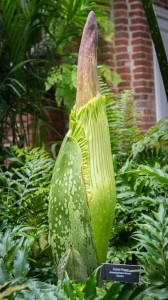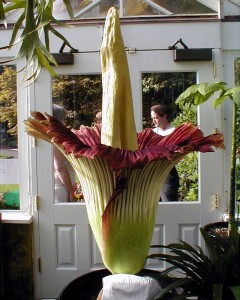Pittsburgh Garden Involved in Big Stink
August 13th, 2013
Flowers are supposed to smell nice. At least we like them when they do.
So go figure that the planet’s stinkiest flower – one that smells like rotting flesh – attracts more attention than just about any other botanical experience. The top-stink honor goes to a fortunately rare plant called the “corpse flower.” Pittsburgh’s Phipps Conservatory happens to have one of them.
This Indonesian native only flowers maybe once every 6 to 10 years, and Phipps’ specimen is about to put on a reeking good show.
Sometime late this month, the Phipps’ corpse flower will extend a single appendage upward to roughly 8 feet and then open into an odd sheath-around-a-column flower of flesh-toned crimson.
That’s when the stink both attracts and repulses legions of fascinated plant-gawkers (not to mention fifth-grade boys).
When a similar corpse flower opened in July at the U.S. Botanic Garden, some 130,000 visitors came to see it. Another 650,000 viewed it online via a live webstream. Check out time-lapse films of that one opening: http://www.usbg.gov/return-titan and http://www.youtube.com/watch?v=zg28auR8nbI.
The Phipps folks are expecting a similar attention boost.
“We plan to stay open until 2 a.m. on the night it blooms since it’s a night-blooming plant and only smells for 12 hours,” says Liz Fetchin, Phipps’ director of marketing and communications. “We want as many people to see it as possible.”
Phipps already is keeping the stink-anticipating public abreast of the plant’s progress through its web site, Facebook page and Twitter (@PhippsNews or https://twitter.com/PhippsNews).
The corpse plant – known botanically as Amorphophallus titanum and sometimes by the other common names of Titan arum and “big stinky” – is an oddball plant in a lot of ways.
It starts out as a huge, flat corm – something along the lines of dormant dahlia. Except a corpse flower corm can weigh in at 150 pounds, making it the world’s heaviest corm.
In the vegetative years, the shoot that arises looks to me like a giant endive that eventually opens into a tree-like canopy.
In a year when the plant decides to flower, the shoot can elongate from 4 feet to 8 feet in a matter of days, making it the world’s largest unbranched flower structure.
Then the sheath-like flower opens around it. At that stage, it looks like something from a Dr. Seuss book… a Martian Dr. Seuss book. It’s very weird, in other words. But in a way, both impressive and beautiful.
The flower doesn’t smell bad because it’s deviant in some way. The idea is to mimic rotting flesh so flies and beetles that like that kind of thing will swarm in and help with pollination.
Phipps’ particular corpse flower has been named “Romero” after horror director George Romero, who filmed his cult classic “Night of the Living Dead” in and around Pittsburgh in 1968.
Phipps bought the plant in 2009 from Tindara Orchid and Garden Supply of Georgetown, Mass., and kept it in the conservatory’s production greenhouse until it began showing signs of imminent bloom.
Earlier this month, the staff moved it into prime real estate in the conservatory’s main Palm House, where it’ll stay until the stink settles.
After the flower dies back, a leaf stalk grows up in its place.
“It’s a very touchy plant, difficult to care for,” says Fetchin. “It’s rare that it blooms in captivity.”
Western plant-fanciers got their first look at a corpse flower in 1889 when London’s Kew Gardens cultivated one.
Since then, numerous public gardens and research growers have taken a crack at coercing the stench out of an Amorphophallus.
Ten of them already have seen blooms so far this year, including Ohio State University, the University of Wisconsin, the Bonn (Germany) Botanical Garden, and a public garden in Stockholm, Sweden, in addition to the U.S. Botanic Garden. Wikipedia has a good list of where corpse flowers have flowered since 1889.
Assuming Romero doesn’t somehow peter out at the last minute, this will be a first-time happening for Phipps.
Although predicting the exact bloom time is tricky, Phipps’ horticulturists think end of August is the likely time frame.
Phipps is located in Schenley Park in Pittsburgh’s Oakland section, about a 3½-hour drive from Harrisburg, if you’re interested in experiencing this event first-hand… er, first-nose, as the case may be.
Otherwise, you’ll have to settle for sight-only online.









